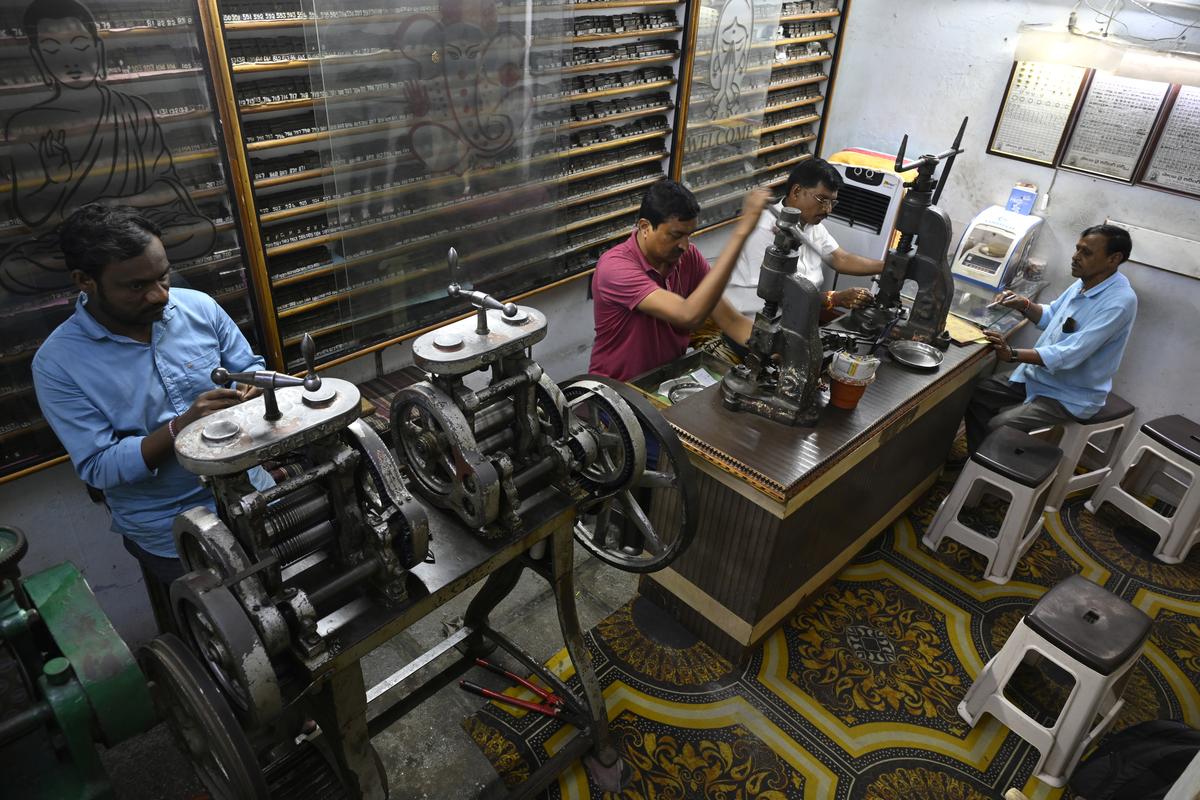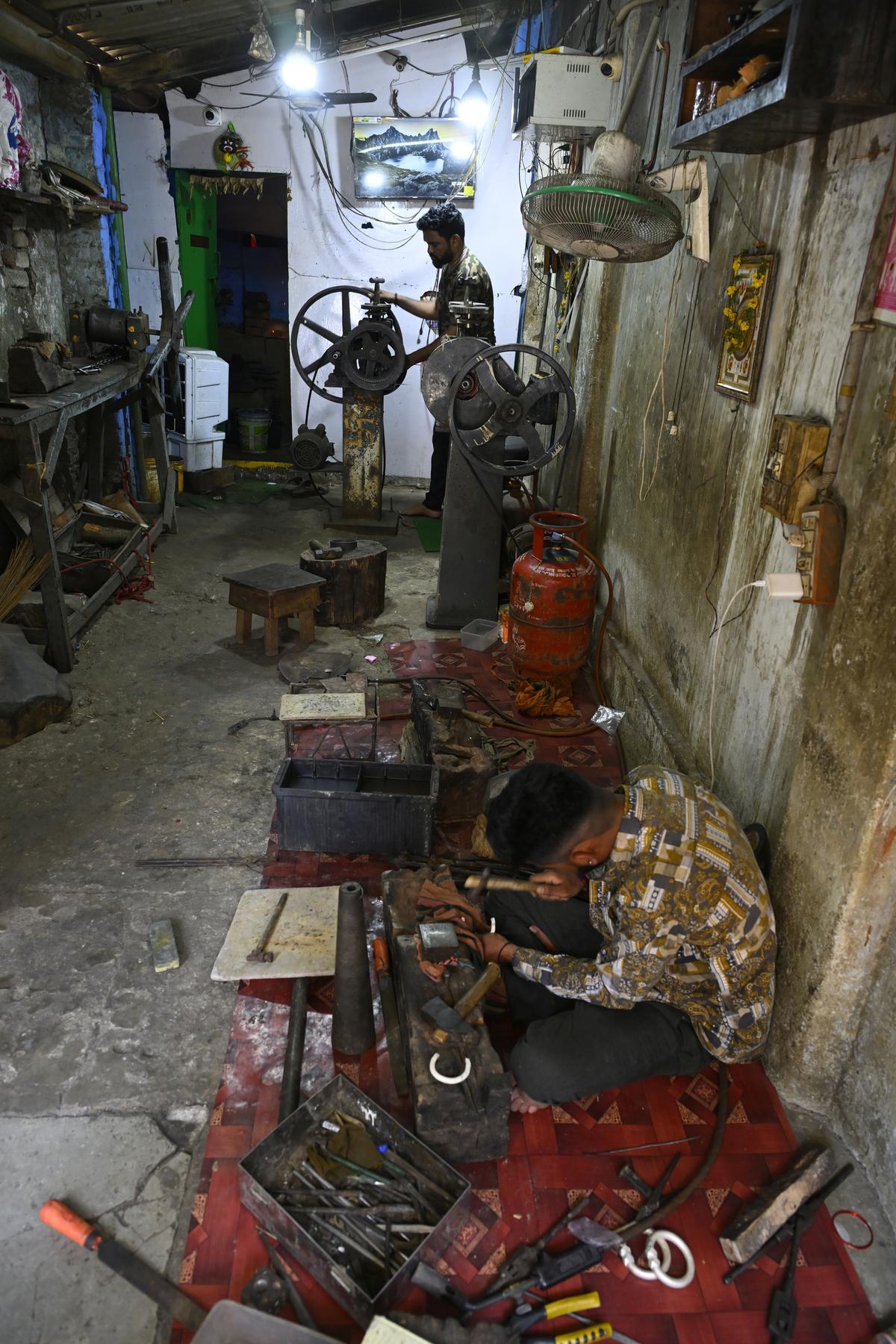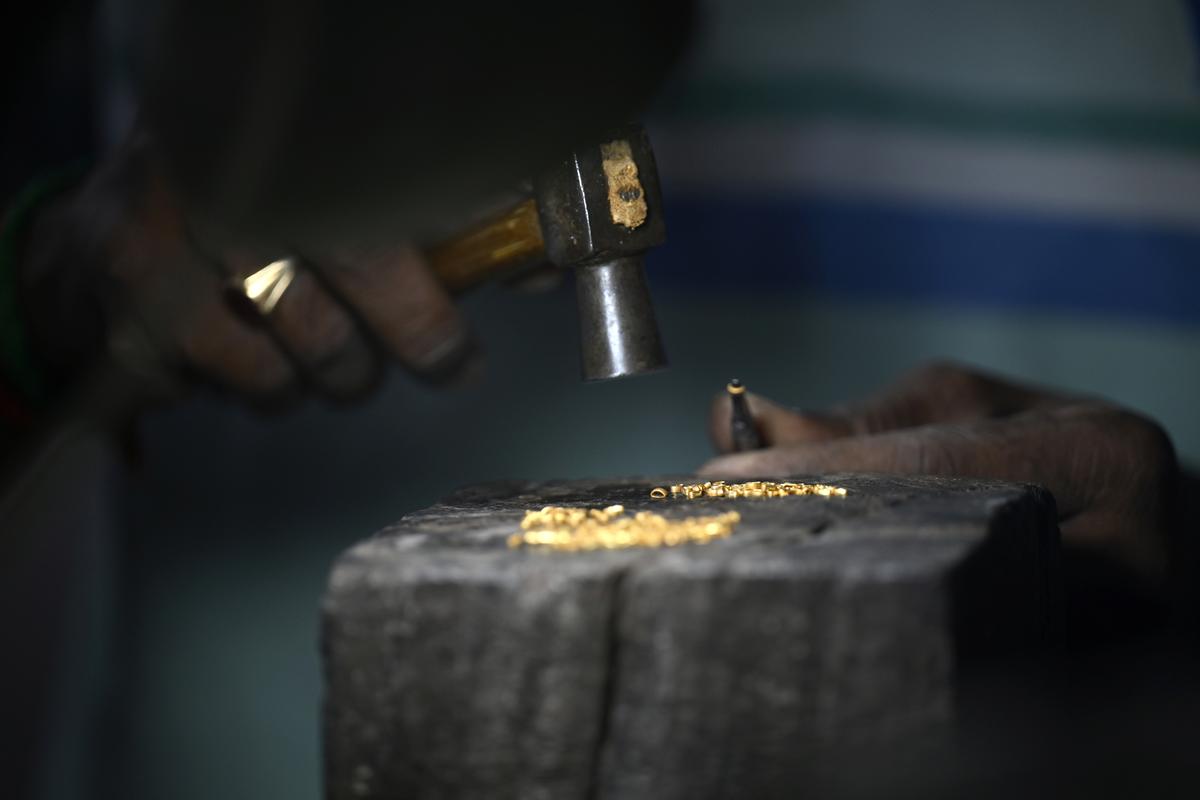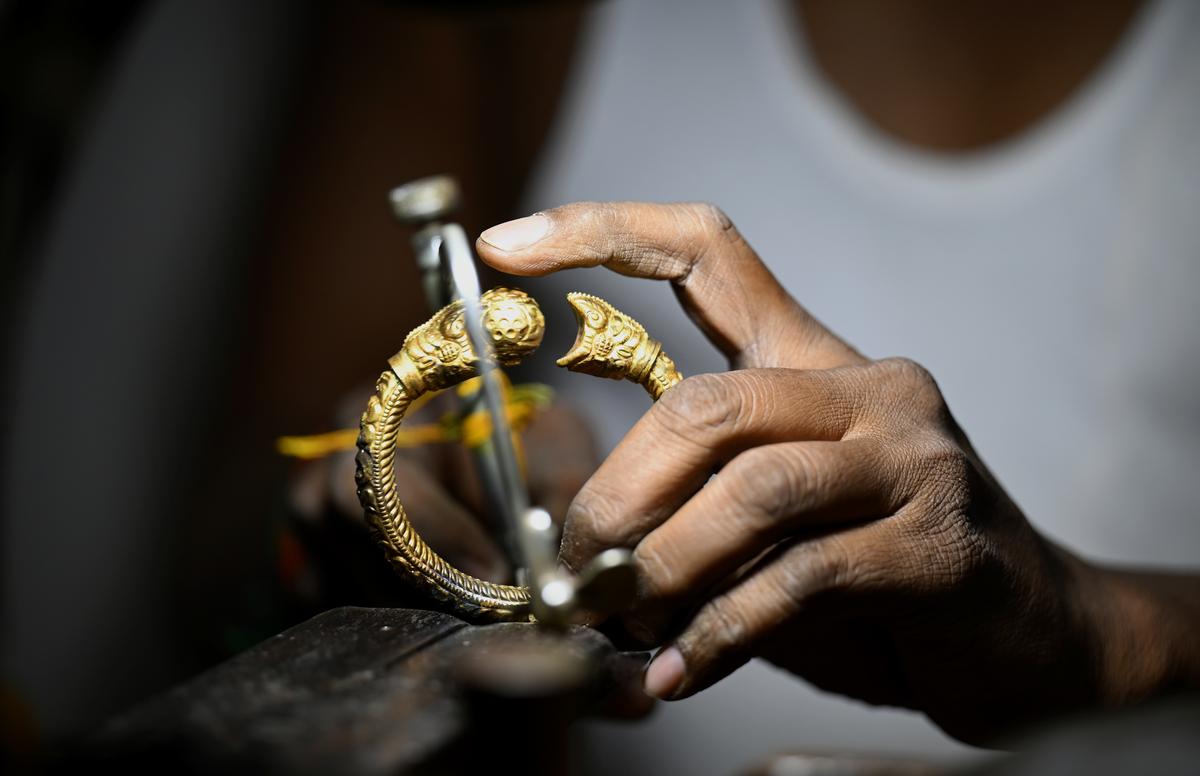Goldsmiths in Telangana: Grief beneath the glitter

Trigger warning: the following article contains references to suicide; please avoid reading if you are disturbed by the subject.
The price of gold has never shone brighter. Step inside a jewellery showroom, with its mirrored walls and machine-cut sparkle, and the perception seems to hold true: gold means good fortune. But behind the polished counters and branded glitz lies a forgotten world — one of quiet workshops, inherited tools, sacred traditions and men who bend over flames and anvils, shaping gold not for profit, but for legacy. It’s here, in the fading lanes of Warangal and other towns in Telangana, that the human cost of gold’s ascent is being counted in silence, sorrow and, sometimes, in death.
“My younger brother Satish and his wife Sravanthi ended their lives due to severe financial distress caused by the sharp decline in demand for their work,” says 39-year-old Warangal resident Vuppula Balu, known locally as Swedhan. The couple, both traditional goldsmiths, consumed cyanide-laced water along with their seven-year-old son in November 2022. The child, who ingested a smaller quantity, survived after treatment. His parents did not.
Since their death, Balu has been raising the couple’s two sons — now aged nine and four — along with his own three children. His aging father, Mohan (66), once a State-level boxing coach, now works as a server at a local biryani stall.
“My leg was fractured and never healed properly. I can’t do gold work anymore. I earn ₹500 a day — just enough to help my son and look after the grandchildren,” Mohan says, his voice heavy with grief.
This story, as crushing as it is, is not isolated.
The soaring price of gold, now well beyond the reach of most middle-class families, has ironically gutted the livelihoods of the very artisans who craft it. Balu was once optimistic, investing ₹20 lakh in a high-end jewellery-making machine. But after his brother’s death and a relentless drop in orders, he was forced to sell it. As of May 15, gold in Telangana stood at ₹97,627.50 for 24 karat and ₹89,491.88 for 22 karat — glittering numbers that only deepen the despair of those who once shaped it by hand.
Another goldsmith, Kadarla Ranjith, who had also invested in similar machinery hoping to modernise, met the same fate as Satish (33), says Balu. He too died by suicide after failing to recover from mounting losses.
“Corporate jewellery shops and big traders have eaten into our business. Customers go there for machine-made designs, hallmark guarantees and air-conditioned comfort. They have stopped coming to us,” he rues.
The traditional goldsmiths — primarily from the Kamsali or Avusula community, part of Vishwa Brahmin, in Telangana — are not just losing customers, they are losing their craft, their confidence and even their will to live. Their work is intricate, generational and deeply tied to customs, especially wedding rituals involving ornaments like the pusthe (mangalsutra) and mattelu (toe rings). Once sacred symbols handcrafted by local artisans, they are now mass-produced and sold at large jewellery showrooms dotting every city and major towns in the State.
“It was a matter of pride to have these ornaments made by your local goldsmith. Now people don’t care. They just buy it off the shelf,” laments G.Nagaraju, 45, another goldsmith from Warangal. He hopes the government will intervene and preserve the tradition by preventing corporate stores from selling culturally significant pieces.
Tradition vs. showroom advantage
Customers like K. Madhavi from Hanamkonda (Warangal) say concerns over quality and delivery timelines often influence their decisions. “We are unsure of the quality of ornaments made by traditional goldsmiths. Jewellery showrooms, in contrast, offer hallmark certification, guarantees and even replacements,” she says. For her daughter’s wedding recently, she purchased all 20 tolas of gold from a showroom, except for the pusthe-mattelu, which were sourced from a local goldsmith.
Affluent buyers are even more unapologetic in their tilt toward branded outlets. “These stores offer intricate, machine-made designs that often outshine handmade ones. Plus, there’s no waiting — you walk in and get what you want,” says Santosh Manduva, a resident of Srinagar Colony (South) in Hanamkonda. “The marketing, the ambience, the offers — it’s an experience, not just a transaction.”

Gold glows but who’s burning?: Goldsmiths at work at a shop on Vishwakarma street, the jewellery hub of Warangal.
| Photo Credit:
NAGARA GOPAL
Consumer preferences, brand marketing and rising gold prices have left little room for the slow, personal artistry of the goldsmith. “People don’t have time anymore,” says Krishna Kumar Sharma, a priest from Karimnagar. “Earlier, the bride’s family would take ornaments from the goldsmith in a procession with drumbeats. Now that’s gone.” Such was the sanctity of the process that even the goldsmith would perform a puja before beginning work on the pusthe and mattelu, an artisan recalls.
Unable to afford rent or keep their shops running, many goldsmiths have switched trades — some drive autorickshaws, others work under bigger traders for daily wages. Those who continue in the trade barely scrape by; the average monthly income of a goldsmith today is just ₹12,000 to ₹15,000.
“I know goldsmiths who don’t even make ₹500 a day now. Their children don’t want to continue in this field. There is no future in this,” says Rudroju Prathap from Girmajipet, Warangal, who works at a shop on Vishwakarma street.
Vinjamuri Raghava Chary, president of the Telangana Rashtra Swarnakarula Sangham, says at least 14 goldsmiths died by suicide in a span of six months in 2022: “In many cases, police don’t register the deaths as financially driven. In August 2022, four members of a goldsmith family in Krishnanagar of Jagtial town ended their lives.”
The tools of their trade — cyanide and acid — have become the means of their demise.
As corporate jewellery chains expand into even the smallest towns, goldsmiths find themselves priced out and pushed aside. “We are not just losing work. We are losing generations of knowledge and tradition,” says Raghava Chary, adding that they have been protesting against setting up of big shops by non-locals.
“Customers don’t realise the hidden costs in showrooms — the wastage, making charges and loss of craftsmanship. There is no trust deficit between us and them; only a visibility deficit,” he points out.
Goldsmiths across Telangana say skyrocketing gold prices and changing buyer preferences are pushing them to the brink. “People are buying less gold, our incomes have dropped and many senior artisans are leaving the trade,” says Mattewada Ajay Kumar, a veteran goldsmith from Warangal. Despite being a renowned micro-artist known for his needle-eye sculptures, Ajay is facing financial hardships due to a sharp decline in orders.
“We can’t compete with big showrooms except in terms of quality and trust. Customers prefer readymade ornaments, thanks to aggressive branding. Even though we can craft diverse designs, we are losing ground, especially to Bengali workers,” he says.

Goldsmiths working hard to make both ends meet by working at Vishwakarma street where hundreds of gold shops are located in Warangal.
| Photo Credit:
NAGARA GOPAL
Thangalapally Satyanarayana (42), a goldsmith from Ramnur village in Jagtial district, travels 100 kilometres every day to run a shop in Mancherial. “I trained for three years under a senior artisan, but now I can’t sustain my business,” he says.
Survival struggle
In Mancherial district alone, 268 goldsmiths depend on the trade. Across the erstwhile Adilabad district, about 2,000 continue to work. Statewide, the number is close to 50,000, although the craft is slowly declining under the pressure of modern jewellery-making technology.
“We have appealed to the government to support us with loans, skill training and pensions like those given to beedi workers and weavers,” says Kannekanti Satyam, former vice-president of Telangana Swarnakarula Sangham from Nalgonda. He says goldsmiths are caught between survival and a dying tradition — and the COVID-19 pandemic as well as surging gold prices have only worsened things.
According to the Nizamabad Goldsmith Association, nearly 300 migrant workers from West Bengal, who work for lower wages, are competing with around 5,000 local artisans. “Earlier, it was healthy competition. Now, we are losing our livelihood. Even villagers now prefer big showrooms over community goldsmiths,” says an artisan, pleading for urgent government intervention.
Others call for skill development initiatives. “One major showroom held workshops, but didn’t train locals, stating we lacked skills. The government should organise training and ensure that traditional goldsmiths aren’t left behind,” he adds.

Raghava Chary shares that there are about 15,000 Bengali goldsmiths working in the twin cities of Hyderabad and Secunderabad alone even as he urges the government to recognise goldsmithing as a cottage industry and extend incentives.
Their association, he says, submitted a representation to Ministers Ponnam Prabhakar and D.Sridhar Babu, seeking the creation of a welfare board for gold and silver artisans, an idea first proposed during Y.S. Rajasekhara Reddy (YSR)’s tenure. “In 2008, YSR appointed a five-member committee to study welfare schemes for goldsmiths in Tamil Nadu and Gujarat. The report was submitted, but the initiative stalled after his sudden demise,” Chary recalls.
The association is now urging the A. Revanth Reddy-led Congress government in Telangana to revive that plan. “We face severe threats from large jewellery manufacturers in Mumbai, Coimbatore, Mangalagiri, and Nellore. We need training centres and manufacturing units in each erstwhile district,” he says, stressing that big brands must employ local artisans.

Many artisans are migrating in search of work. T. Ravindra Chary, who once worked in Jagtial, moved to Mumbai a year ago. “I now earn ₹10,000-15,000 a month on a piece-rate basis,” he avers.
Cultural erosion
The crisis for the Kamsali community is both economic and cultural. The craft, passed down through generations, is learned not in institutions, but through hands-on mentorship. “We don’t learn this craft in an institute or through books. It is an oral tradition, perfected over decades under the watch of our elders,” says Rudroju Prathap, whose father, Malla Chary, was also a goldsmith and died by suicide due to financial distress. “I took up the trade, but I have advised my children not to. There is no dignity or security in this profession anymore.”
The ripple effect is felt in families too. As work dries up, roles traditionally held by women and children in supporting tasks have vanished.
Despite repeated appeals, goldsmiths in Telangana have received little structured support from the government. “No formal survey has been done to identify and document goldsmiths as a distinct artisanal group requiring assistance,” says Mattewada. In contrast, Tamil Nadu and Andhra Pradesh have implemented robust welfare policies. Tamil Nadu offers pensions, insurance and toolkits through its Artisans Welfare Board. Gujarat, another major jewellery hub, has invested in skill centres and integrated artisan networks into its industrial policy.
Adding to the strain is the industry’s technological shift. Even master craftsmen find it hard to compete with machines on speed and cost, despite offering finer workmanship. “Earlier, hand-carved designs were in demand. Now it is all CAD and 3D printing,” explains Mattewada.
The tools still hang, the benches still stand, but the work and the pride it once brought is slipping away. As weddings grow grander and jewellery glossier, fewer pause to ask who shaped the pieces, or what it took to keep a centuries-old craft alive. For Telangana’s goldsmiths, the question now is no longer just of livelihood, but also of legacy.
(Roshni suicide prevention helpline: 8142020033/ 8142020044, between 11 a.m. and 9 p.m. daily; email: roshnihelp@gmail.com)
Published – May 16, 2025 08:43 am IST



